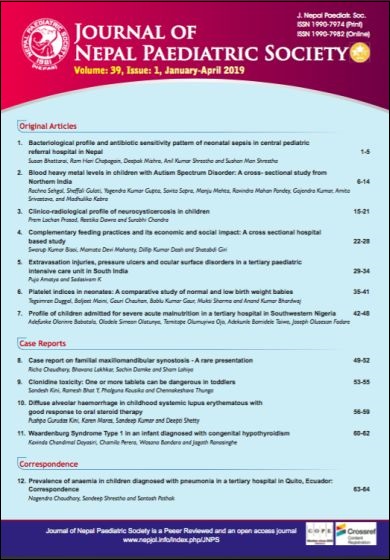Complementary Feeding Practices And Its Economic And Social Impact: A Cross Sectional Hospital Based Study
DOI:
https://doi.org/10.3126/jnps.v39i1.26473Keywords:
complementary feeding, income group, mother education, commercial processed cerealsAbstract
Introduction: According to NHFS-4 data, around 38% of under-five Indian children are malnourished and stunted. In addition to poor socio-economic status, faulty complementary feeding practice is a major contributor to this. The objective of this study is to know the prevailing complementary feeding practices in our area, the most common food type preferred for introduction during initiation of complementary feeds, knowledge of the mother and their family members regarding complementary feeding, the factors influencing in decision making and its financial burden on the family.
Methods: This hospital based cross-sectional study was conducted in a private Medical College in Bhubaneswar, Odisha, India. 256 mothers of infants between six months to two years attending Paediatric OPD from December 2018 to June 2019 were selected by random sampling technique. Data were collected using a structured questionnaire.
Results: Out of the total 256 subjects interviewed, 134 (76.13%) out of 176 families belonging to lower income group preferred commercially available processed food over home food as the initial weaning food as compared to 32 (40%) out of 80 of the high income group preferring the same. The lower income group spent 22.3% of the total family income on commercial preparations to feed their infants in the age group six to 12 months. Whereas high income group families spend an average of 14.3% of family income on baby food products in the same age group. Despite being in regular contact with the local physician, in 85% of the total visits to the doctor, the opportunity wasn’t utilised to counsel the family member about complementary feeding practices.
Conclusions: Commercial preparations are the primary preferred weaning food. The dietary diversity of complementary food is very poor, thus affecting growth and development. The false perception that commercial preparations are critical to child growth and development is overburdening the family finances.
Downloads
Downloads
Published
How to Cite
Issue
Section
License
Authors who publish with this journal agree to the following terms:
Authors retain copyright and grant the journal right of first publication with the work simultaneously licensed under a Creative Commons Attribution License that allows others to share the work with an acknowledgement of the work's authorship and initial publication in this journal.
Authors are able to enter into separate, additional contractual arrangements for the non-exclusive distribution of the journal's published version of the work (e.g., post it to an institutional repository or publish it in a book), with an acknowledgement of its initial publication in this journal.
Authors are permitted and encouraged to post their work online (e.g., in institutional repositories or on their website) prior to and during the submission process, as it can lead to productive exchanges, as well as earlier and greater citation of published work (See The Effect of Open Access).



